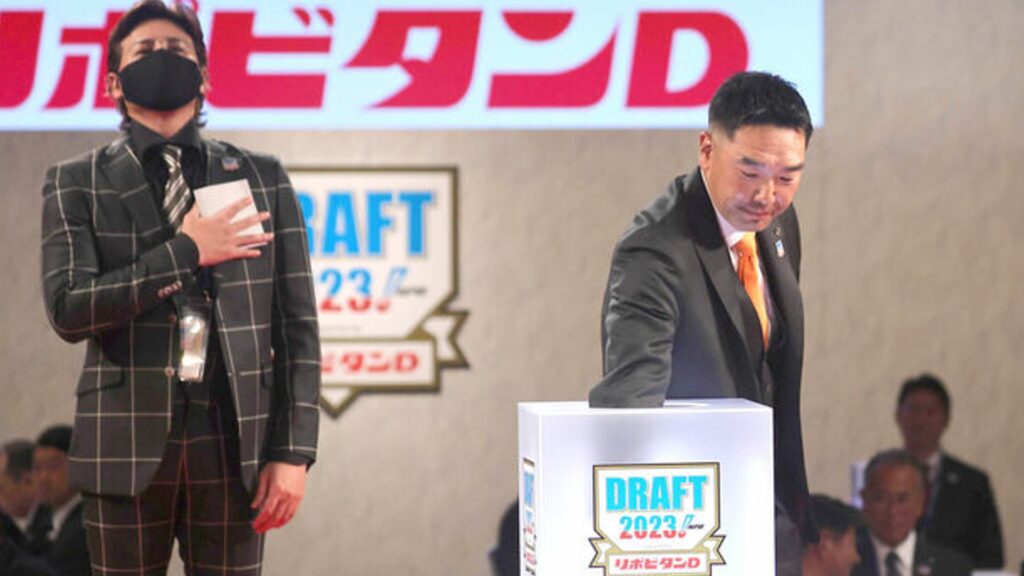
The much-anticipated 2023 Nippon Professional Baseball Draft has concluded as hundreds of young players saw their dreams come true by having their names called. Let’s examine the top storylines of the night and how each of the 12 franchises navigated the stressful process this year. It’s impossible to know how strong a draft class actually is until five, ten, or even twenty years after the draft. Still, I’ll attempt to assess the teams based on 1) the potential ability of the draftees, 2) how well the team’s needs were addressed, and 3) how effectively the team’s pre-draft plans were executed to assign them a letter grade from A to F.
The Elephant in the Room: Rintaro Sasaki
This was the first time in four years that the NPB Draft was held with a live audience, bringing back the warm pre-COVID atmosphere, but the absence of one missing face still penetrated the air. Just over two weeks prior to the Draft, 17-year-old Rintaro Sasaki — widely regarded as one of the best prospects in Japanese history — stunned the baseball world by announcing his intention to skip the NPB Draft and pursue college in the United States instead. The news came after months of speculation about Sasaki’s future, as Japanese fans eagerly awaited whether their favorite team would have the chance to draft him. The idea that he would cross the Pacific was always a possibility, but few expected it to actually become a reality. Shohei Ohtani and Kotaro Kiyomiya also contemplated passing on NPB in the past but determined it was too risky to cross the Rubicon. Sasaki’s decision is truly unprecedented.
Those who follow high school baseball in Japan will surely be familiar with the 6-foot, 250-pounder. Not only did he bat cleanup for Hanamaki Higashi High School, but he’s also the son of manager Hiroshi Sasaki. The Iwate school has become somewhat of a household name among baseball fans worldwide, given that Major Leaguers Yusei Kikuchi and Shohei Ohtani are both alumni who played under Sasaki. Rintaro surely grew up watching the likes of Kikuchi and Ohtani come and go from Hanamaki Higashi, knowing that he, too, would have the opportunity to play under his father someday. During his three years at Hanamaki Higashi, Sasaki blew away the competition, setting the unofficial all-time high school home run record with 140, breaking Kotaro Kiyomiya’s previous record of 111 homers. Sasaki is passing up on the chance to become a young NPB superstar so he can join an MLB organization immediately after college instead of waiting to be posted.
By some calculations, Sasaki is losing out on millions of dollars in the short term. Fellow slugger Munetaka Murakami, for instance, will make well over $20 million in his NPB career before his 26th birthday, including awards and bonuses. On the one hand, if Sasaki’s primary ambition is to become a premier hitter on the world stage, the move will help him adapt quicker to the American baseball culture and perhaps hone a skill set more suited for modern MLB. On the other hand, NCAA Division I baseball is far weaker competition than what he would have been exposed to in the professional landscape in Japan, raising concerns that he may be stagnating his own development.
In the wake of Sasaki’s decision, NPB has extended the draftee signing deadline to the following July after the draft (previously it was March), affording Japanese students at overseas high schools and universities a chance to finish their education and even await the results of the MLB Draft. If Sasaki enrolls in a U.S. school in 2024, he will be eligible for the MLB Draft in 2026, but this rule change expands his options to possibly reconsider a path to NPB.
The Not-So ‘Big 3’

Coming into the year, three high school sluggers stood out as the top hitting prospects of the class: Rintaro Sasaki of Hanamaki Higashi, Keita Manabe of Koryo, and Kyoshiro Sakura of Kyushu International. We already know Sasaki skipped the draft, but where did the others land? Shockingly, Sakura was the only player drafted, and he fell all the way to the second Ikusei (developmental) round for the Hawks. Manabe, meanwhile, made up his mind before the draft that he would pursue higher education if he did not get his name called before the fourth round. It seemed like a given that Manabe would be a first-rounder or, at the very least a second-rounder. As it turns out, every team passed up on Manabe three times, and his decision to go to college was confirmed the moment the third round ended. He will try again in four years.
Lots of Lotteries
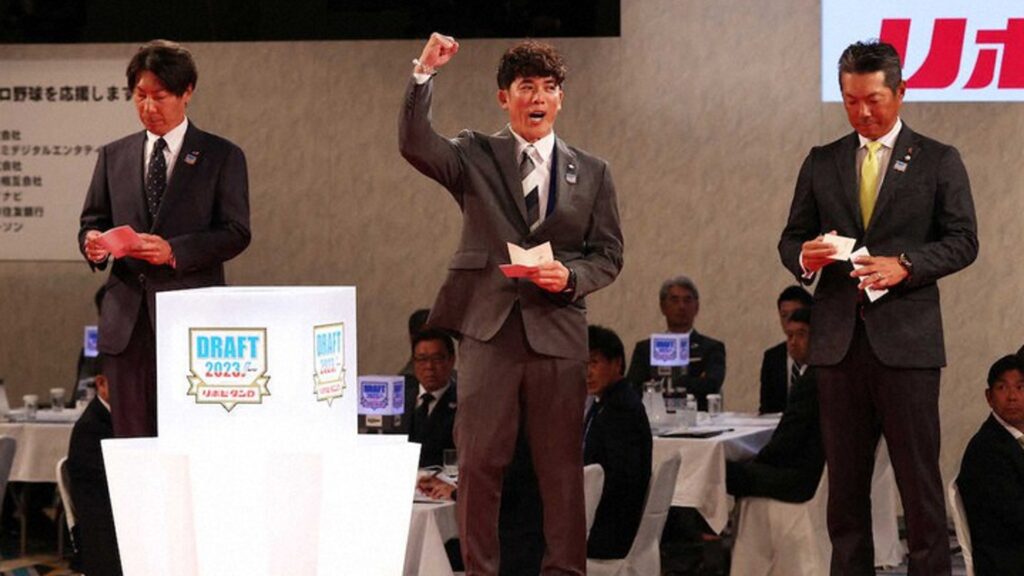
Last year was an unusual draft as nine teams publicly announced their nomination before draft day. Most teams were happy with the prospect of their choice and didn’t want to step on anyone else’s toes, leading to just two contested players (Shogo Asano, Kosei Shoji). This year was a different story, as only five teams publicly revealed their pick, and we saw four contested players in the first phase of the first round alone and seven contested players in total (Natsuki Takeuchi, Ryuki Watarai, Hayato Tsunehiro, Yuhi Nishidate, Sho Kusaka, Yugo Maeda, Haruki Hosono). This doesn’t necessarily speak to the higher quality of the draft class as a whole this year, but it certainly made the viewing experience more exciting.
Independent Leaguers Aplenty
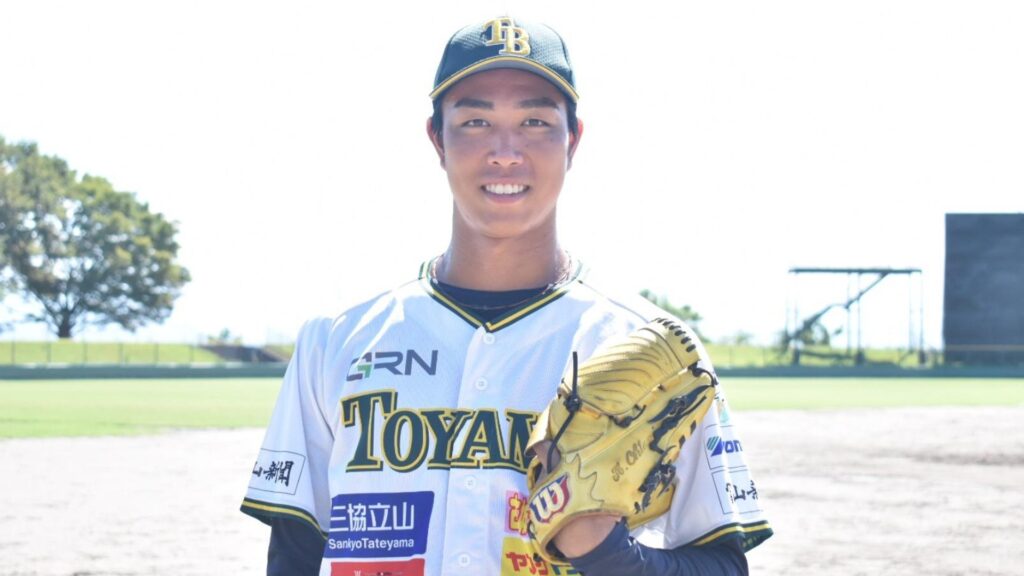
The prevalence of dokuritsu (independent league) and shakai-jin (corporate/industrial league) players in the draft is a unique aspect of Japanese baseball, as prospects in leagues unaffiliated with NPB have a direct pipeline to the pros. Compared to shakai-jin players, who have an employee contract with the company they play for and are highly regarded, dokuritsu players typically don’t receive as much love in the draft as only a small handful of draftees in any given year come from indy ball. This year, however, a record-setting 23 players belonging to an independent league team were drafted, including two in the second round – further proof that players who are not good enough at the high school or college level can still continue their baseball careers in an independent league with the hopes of making it to the pros one day.
Team Draft Grades
Chunichi Dragons (5 Pitchers, 4 Hitters)
Top Five Picks: RHP Sho Kusaka (Asia University), IF Keishi Tsuda (Mitsubishi Juko East), IF Rintaro Tsujimoto (Sendai University), LHP Konosuke Fukuda (Riseisha HS), RHP Shota Habu (Ibaraki Astro Planets)
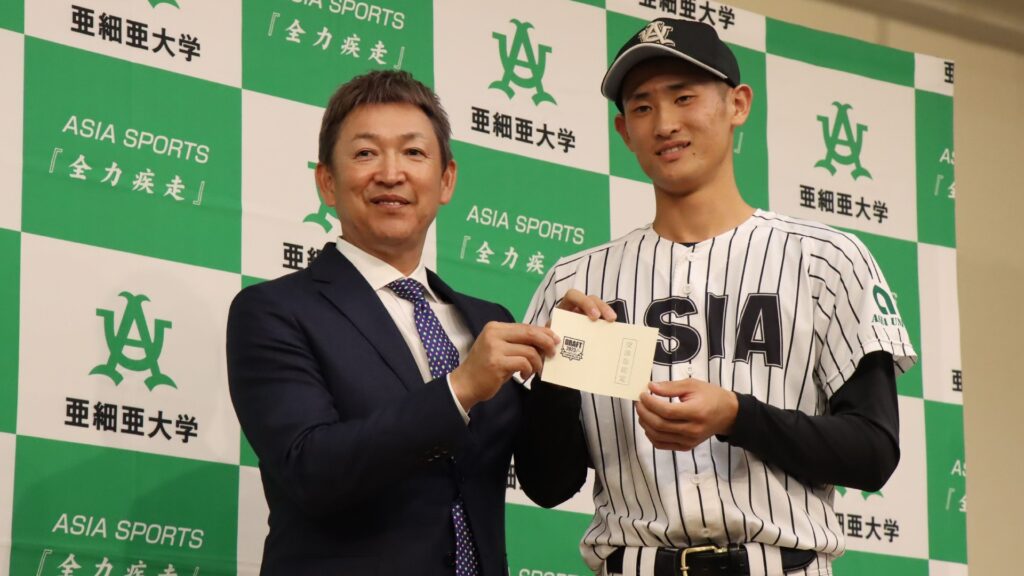
The Dragons gave manager Kazuyoshi Tatsunami free rein over the team’s drafting decisions, and he made a surprise decision on the night before the draft by announcing his intention to nominate ENEOS outfielder Ryuki Watarai. Unfortunately, the Dragons were unable to land their top choice as they lost the three-way lottery to the Baystars. At that point, Chunichi pivoted to the lanky but gritty right-hander Sho Kusaka out of Asia University. Though pitching has been a strength of the team in recent years, their league-worst 4.17 ERA on the farm this season certainly raised alarms for the shortcomings of their next generation of arms. With veterans Yudai Ohno and Hideaki Wakui in the tail-end of their careers, Kusaka’s presence will be crucial for the continued success of Chunichi’s rotation in the coming years.
The rest of the Dragons’ draft was uninspiring, to say the least. As the worst team in NPB this season, the Dragons were in a strong position with the first overall pick of the second round but made a questionable selection with defense-first middle infielder Keishi Tsuda despite many higher-end prospects being available at the 13th overall position. Chunichi then doubled down in the third round with another defensively-oriented middle infielder, Rintaro Tsujimoto. Particularly after drafting five infielders in the 2022 draft, one has to wonder if Tatsunami – a Hall of Fame infielder himself – will ever be content with what he has.
The Dragons didn’t do anything to suggest they’re serious about contending next season. If they make a jump forward, it’ll likely be thanks to the young players already in their organization.
Grade: C-
Hokkaido Nippon-Ham Fighters (2 Pitchers, 6 Hitters)
Top Five Picks: LHP Haruki Hosono (Toyo University), C Yuya Shinto (Jobu University), OF Kazuki Miyazaki (Yamanashi Gakuin University), IF Ryosuke Miyose (Kagoshima Josei HS), OF Hinode Hoshino (Maebashi Kogyo HS)
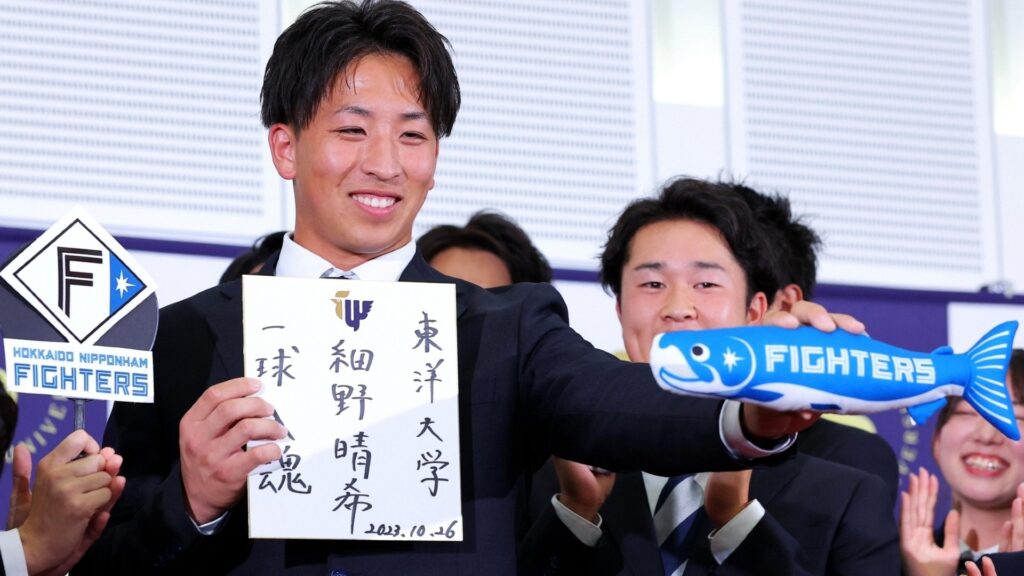
After losing the lotteries for pitchers Yuhi Nishidate and Yugo Maeda in the first round, Nippon-Ham “settled” on Toyo University southpaw Haruki Hosono. The fact that Hosono – who throws up to 98 mph and has the highest ceiling of any pitcher in the class – was still available so deep into the first round was quite a shock, as he was projected to be one of the most contested prospects of the night. Teams were seemingly turned off by his occasionally erratic command, but one could argue that the Fighters accidentally stumbled into not only the best pitcher but the best player in the entire draft. Hosono has the makeup of a true ace down the line and should immediately factor into the rotation in 2024 as the team prepares to post Naoyuki Uwasawa to MLB.
With their next two picks, the Fighters grabbed two elite defensive college prospects in catcher Yuya Shinto and outfielder Kazuki Miyazaki, both of whom were rumored to be first round candidates. Shinto is one of the best true catchers out of college in recent decades, with phenomenal instincts behind the dish and a cannon arm to stop the running game. Miyazaki is one of the best all-around athletes of the class, using his lightning speed to steal plenty of bags and lock down center field. His bat is not as much of a certainty, but he has the ability to develop into a solid leadoff hitter in the future. Their fourth-round pick, Kagoshima Josei High School corner infielder Ryosuke Miyose, is another very promising asset with a big frame and massive raw power to tap into.
Some will question why the Fighters didn’t add more pitching, but they played their cards effectively and stumbled into one of the better drafts of the night.
Grade: A-
Yakult Swallows (4 Pitchers, 3 Hitters)
Top Five Picks: RHP Kota Nishidate (Senshu University), RHP Kengo Matsumoto (Toyota), LHP Yuki Ishihara (Meiji University), C Kyo Suzuki (Tokoha Kikuchikawa HS), IF Ryui Itoh (Niigata Albirex)
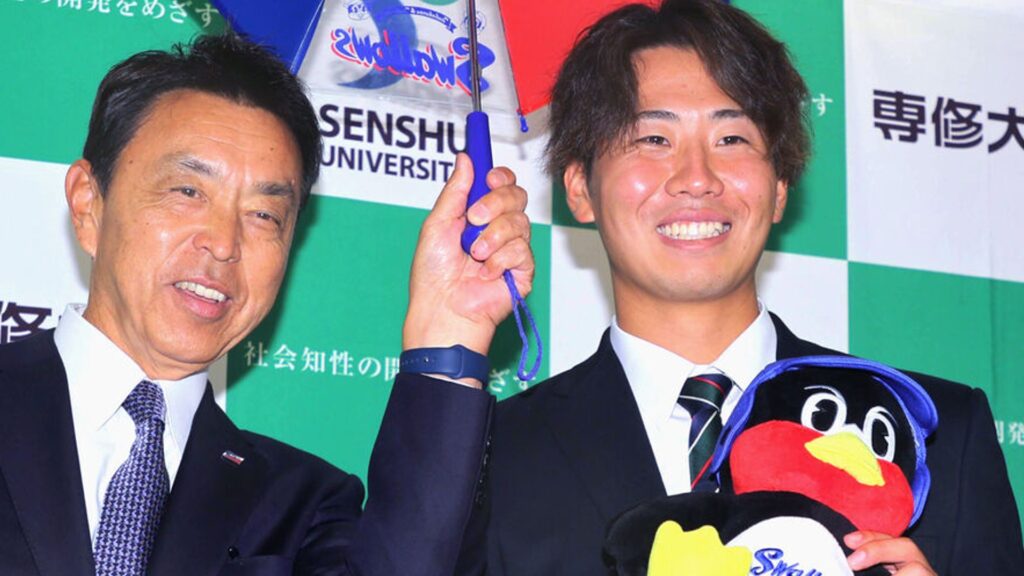
The Swallows were out of rhythm all year, but the primary culprit of their problems remained the pitching, as their 3.66 ERA and 3.97 FIP ranked dead last in NPB. Munetaka Murakami’s looming departure to MLB after the 2025 season also presents an urgent need for Yakult to win now. To address the pitching deficiency, the Swallows nominated Natsuki Takeuchi with their first-round pick but lost the lottery to Seibu. Though flamethrower Haruki Hosono was still on the board at that point, Yakult elected to go for a more lowkey pick in Senshu University righty Kota Nishidate for their redraft selection. Nishidate was projected to be an early second rounder but already has a professional build at 6-foot-2, 190 pounds, with plenty of room to grow into a solid starter. That said, Nishidate doesn’t move the needle forward as much as Takeuchi would’ve, and passing up on Hosono seems like a missed opportunity to grab a potential future ace.
There was some speculation that the Swallows would add a bat or two in the early rounds, but they instead opted for two more NPB-ready arms in Toyota right-hander Kengo Matsumoto and Meiji University left-hander Yuki Ishihara in the second and third rounds, respectively. They also added a half-Taiwanese high school pitcher, Shohei Takahashi, in the developmental rounds.
While Yakult no doubt improved their pitching situation overall, the draft came across as a bit of a half-hearted effort as they took “quantity over quality” instead of taking bigger risks on pitchers with higher ceilings.
Grade: C+
Seibu Lions (9 Pitchers, 4 Hitters)
Top Five Picks: LHP Natsuki Takeuchi (Koku Gakuin University), RHP Taiga Ueda (Osaka Shogyo University), LHP Haruki Sugiyama (Yokohama HS), RHP Haruse Narita (Hirosaki Technical HS), RHP Taisei Miyazawa (Tokushima Indigo Sox)
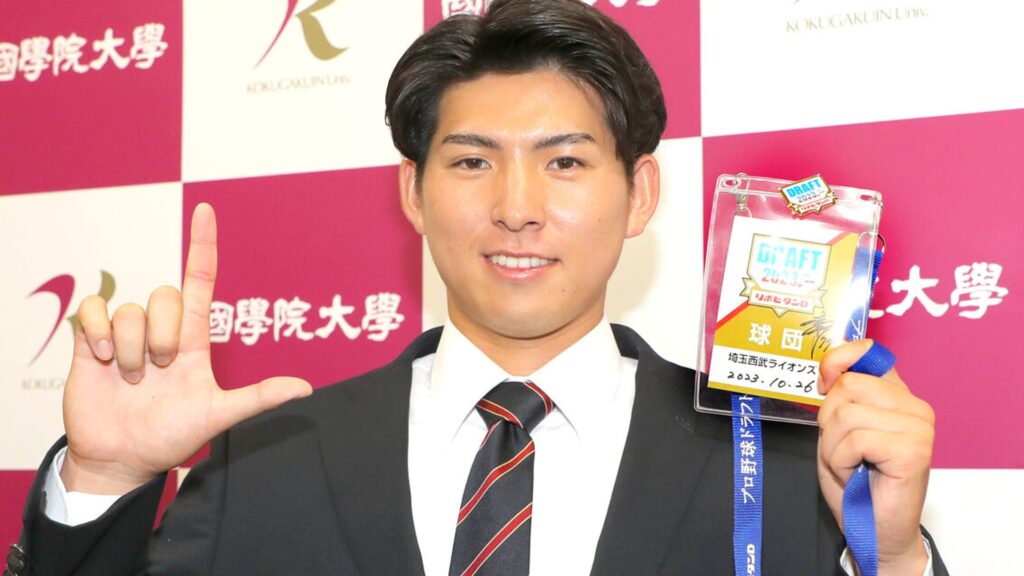
For their top choice, GM Naoto Watanabe set his sights on Koku Gakuin southpaw Natsuki Takeuchi, evaluating him as the best player of the class, and manager Kaz Matsui drew the golden ticket in the three-way lottery to secure his rights. With Kona Takahashi expressing MLB aspirations and Kaima Taira possibly doing the same in the near future, Takeuchi adds much-needed depth to a very young rotation. Takeuchi has a strong frame, commands the ball well, and has a good feel for all his secondaries, making him an instant Rookie of the Year candidate in 2024. And Seibu wasn’t done — drafting pitchers with each of their first five picks, including Osaka Shogyo University righty Taiga Ueda in the second round, who made big jumps in the scouting industry and media in the months leading up to the draft.
The team struggled to find consistent shutdown options in the back end of the bullpen this year due to the void left by Taira’s conversion to a starter, so pitching was indeed a concern, but the sheer number of arms the Lions drafted seems a bit excessive. They drafted first baseman Kento Watanabe and outfielder Takuya Hiruma with their top picks in 2020 and 2022, so it’s clear Seibu is putting their trust in the internal hitting prospects to break out. However, 2021 first rounder Chihiro Sumida expressed concerns about the lack of hitters his team drafted, saying, “I needed to do better from a pitching standpoint. I’ll do my best next year so the team will be able to draft more hitters.”
Drafting based on ‘best available’ rather than team needs is absolutely a valid philosophy, but failing to address the team’s offensive shortcomings altogether may prove costly, as Seibu’s lineup has been totally toothless in recent years.
Grade: B-
Yomiuri Giants (6 Pitchers, 6 Hitters)
Top Five Picks: RHP Yuhi Nishidate (Chuo University), LHP Shunya Morita (Honda Suzuka), OF Shunsuke Sasaki (Ehime Mandarin Pirates), IF Yuta Izuguchi (NTT West Japan), LHP Teppei Mataki (Nippon Life)
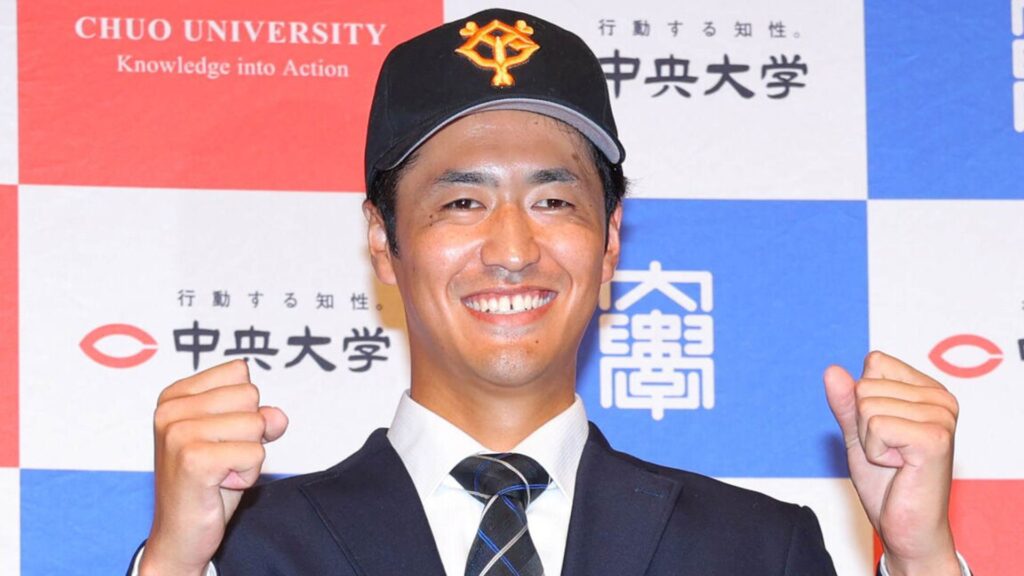
Though Yomiuri led NPB in home runs this season and had some promising developments in the starting rotation, the bullpen proved to be an enormous hole. To address this problem, the Giants nominated and won the lottery for Chuo University right-hander Yuhi Nishidate, who has some of the best raw stuff in the class. He should get an opportunity to start in the future, but he currently profiles more like a reliever with his quick pitch delivery and concerns surrounding his consistency in command. Nonetheless, Yomiuri fulfilled their top priority by securing a high-octane arm.
From the second round onwards, the Giants took an unorthodox approach by going heavy on independent and industrial leaguers — prospects that are perhaps more NPB-ready as role players but don’t possess extraordinarily high ceilings. This signals that the Giants are largely content with their main roster and believe these smaller complementary pieces will help the team compete for a pennant next season. Most of the players Yomiuri drafted are on the older end of the spectrum (like 2022 fourth rounder Hiromasa Funabasama), so they’ll be expected to contribute at the top level immediately and won’t have the same time to hone their skills on the farm as many other draftees are afforded. As such, Shinnosuke Abe and the rest of the coaching staff will have the difficult task of integrating the prospects into the team quickly without overextending them.
Yomiuri should be praised for having a clear game plan in targeting specific players that other teams possibly overlooked, but many would argue they got too cute with the process.
Grade: C+
Rakuten Eagles (5 Pitchers, 3 Hitters)
Top Five Picks: LHP Tatsuki Koja (Toin Yokohama University), RHP Haruto Sakai (Takigawa HS), RHP Naoki Hinata (Tokadai Sugao HS), IF Jumil Rikai Waters (Wellness Okinawa HS), RHP Takuma Matsuda (Osaka Sangyo University)
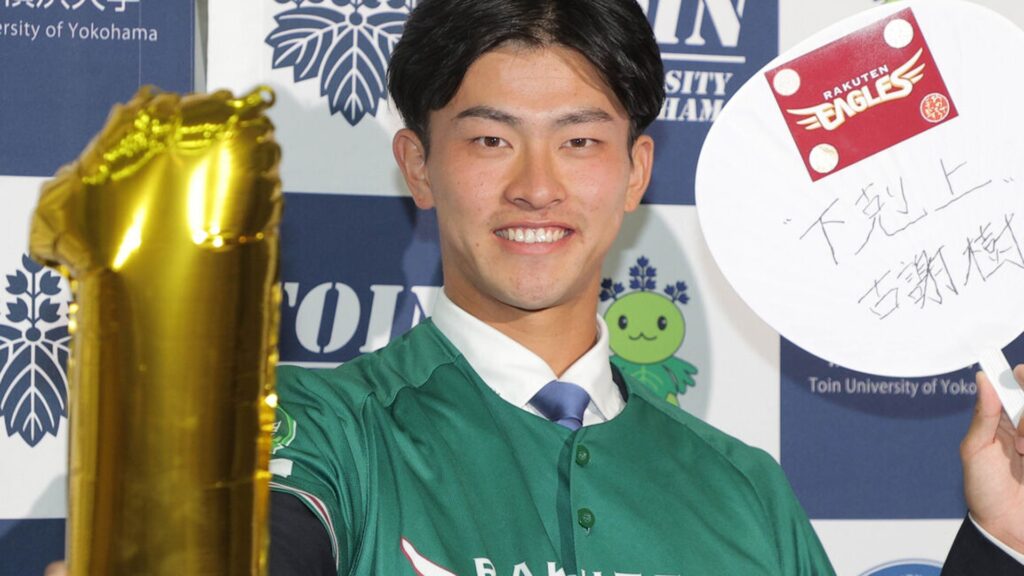
The Eagles lost the lotteries for Hayato Tsunehiro and Yugo Maeda, but they were able to secure southpaw Tatsuki Koja as an uncontested fallback option. Koja profiled like a third or fourth rounder coming into the year but greatly increased his stock with a strong senior spring at Toin Yokohama University. With his plus stuff, Rakuten will hope Koja leads their regressing, veteran-heavy rotation toward greener pastures alongside fellow youngsters Takahisa Hayakawa and Kosei Shoji.
But the Eagles’ second-round selection is even more exciting. Takigawa High School righty Haruto Sakai stands in at 6-foot-1 and has a devastating forkball that many scouts believe is already good enough to get whiffs at the NPB level. As he puts on more weight and grows into his body, it’s easy to dream of Sakai fast-tracking into an ace like Shunpeita Yamashita or Hiroto Takahashi, just a couple of years removed from high school. Fourth-round middle infielder Rikai Waters is also a raw athletic talent to keep an eye on.
Despite failing to get Tsunehiro or Maeda, Rakuten addressed their lack of pitching depth by adding high-caliber college and high school arms.
Grade: B
DeNA Baystars (4 Pitchers, 6 Hitters, 1 Two-Way Player)
Top Five Picks: OF Ryuki Watarai (ENEOS), RHP Ryoto Matsumoto (Meijo University), TWP Riku Takeda (Yamagata Chuo HS), IF Taiki Ishikami (Toyo University), RHP Yutaro Ishida (Chuo University)

With Shota Imanaga set to go to MLB, Kenta Ishida possibly testing free agency, and Trevor Bauer being a wild card, many expected the Baystars would pursue a college pitcher with their top choice. Instead, they took a gamble on ENEOS Corporation outfielder Ryuki Watarai and won the three-way lottery for him. Watarai is widely regarded as the best pure hitter and the most NPB-ready bat of the class, so he will be expected to get significant playing time on the top team from year one. His defensive versatility will also afford DeNA a chance to plug him in wherever needed, though right field will likely be his main home.
The Baystars went on to take Meijo University righty Ryoto Matsumoto and Yamagata Chuo High School two-way prospect Riku Takeda with their next two picks. Matsumoto has a funky delivery and a deceptive sidearm sling, profiling as a finesse reliever. It’s interesting that DeNA chose him over his teammate, Shunsuke Iwai, who has a better chance to make it as a starter. Takeda was labeled as a pitcher when his name was called, but he showed off his prowess on both sides of the ball at the U-18 World Cup in Taipei this September. A lot will be riding on whether they can develop him as a two-way player or if they will eventually make him choose one or the other.
The Baystars failed to answer the question marks in their starting rotation next season but secured the best hitter of the class, added an impact reliever, and decided to take on an intriguing two-way project.
Grade: B
SoftBank Hawks (10 Pitchers, 5 Hitters)
Top Five Picks: LHP Yugo Maeda (Osaka Toin HS), RHP Shunsuke Iwai (Meijo University), IF Ryuta Hirose (Keio University), RHP Kenichi Murata (Meiji University), RHP Ryotaro Sawayanagi (Roki Techno Toyama)
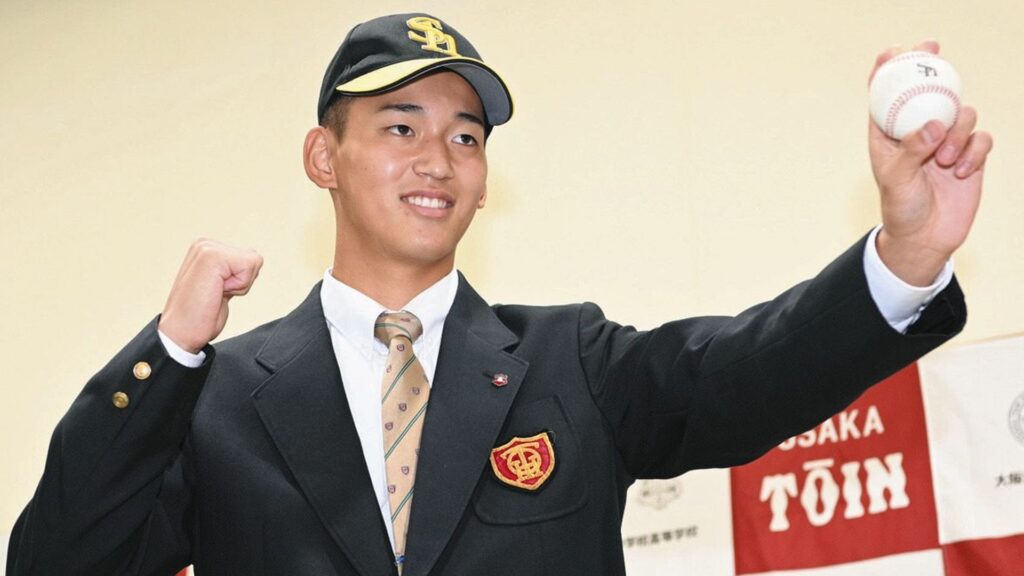
The once-mighty Hawks have struggled to draft stars in recent years, but they improved their squad across the board this time around, and then some. After losing the lottery for Takeuchi to Seibu, SoftBank won the draw for their top fallback option in southpaw Yugo Maeda. Coming out of a powerhouse high school in Osaka Toin, Maeda doesn’t fit the mold of the typical under-the-radar pick that the Hawks have tended to favor lately, but Fukuoka is a great environment for him to develop into an ace with veteran lefty Tsuyoshi Wada as a potential mentor. He currently only throws in the high-80s to low-90s, but he proved he has the command and poise of an experienced stud with a pair of gems at the U-18 World Cup in September. His changeup is one of the best pitches of the class, and he expects to reliably get whiffs and soft contact.
In the second round, the Hawks picked up Shunsuke Iwai, who has been clocked at 97 mph with 2700+ rpm on his fastball. He should factor into the bullpen next year with a chance to join the rotation down the line. In the third round, the Hawks took corner infielder Ryuta Hirose, who has one of the best power tools in the class. His stock fell this spring when he batted under the Mendoza line at Keio University, but there’s no question he can hit the ball to the moon when he connects. They also added other notable prospects, including pitcher Kenichi Murata (fourth round), pitcher Ryotaro Sawayanagi (fifth round), and first baseman Kyoshiro Sakura (third developmental round).
SoftBank managed to have a diverse, well-balanced draft in terms of prospect age and positions while also leaving room to take a flier on sluggers with big upsides.
Grade: A+
Hiroshima Carp (6 Pitchers, 2 Hitters)
Top Five Picks: RHP Hayato Tsunehiro (Aoyama Gakuin University), LHP Taichi Taka (Osaka Shogyo University), LHP Kazuki Takita (Seisa Dohto University), IF Yuto Nakada (Okinawa Shogaku HS), RHP Kento Akatsuka (Chukyo Gakuin University)
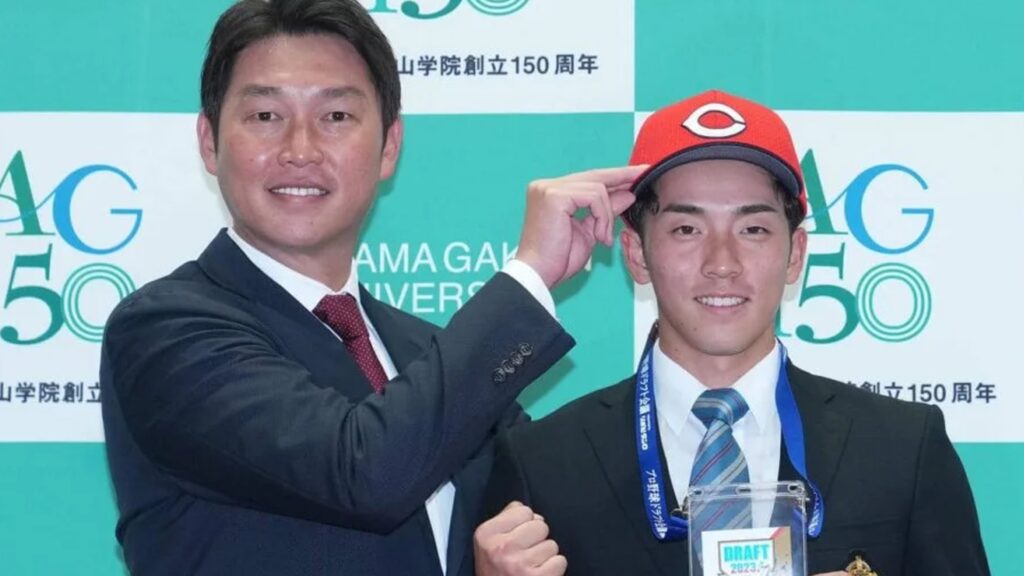
For the fifth straight year, Hiroshima drafted a pitcher in the first round, this time Aoyama Gakuin right-hander Hayato Tsunehiro. The Carp were the first team to announce their pick publicly, and it may have successfully scared teams away as only the Eagles contested their pick. Tsunehiro dominated the Tohto University League and played a major role for the Collegiate National Team in North Carolina this summer, leading Japan to victory as both the ace and closer. His command isn’t perfect, but with a low to mid-90s fastball and strong secondaries, Tsunehiro generates plenty of whiffs and profiles similar to Takayuki Kishi of Rakuten.
Third-round selection Kazuki Takita out of Seisa Dohto University showcased rapid growth during his college career, jumping from a fastball in the mid-80s in his senior year of high school up to a max velo of 95 mph this year. His control is often all over the place, so there’s a lot of work to be done, but his strikeout stuff should translate to the pros. Fourth-round infielder Yuto Nakada is another solid pickup with a big power-hitting frame at 6-foot-1, 210 pounds.
Winning Tsunehiro – who some scouts consider to be the best all-around pitcher of the class – is a huge prize, and the Carp made an astute choice in adding a healthy mix of college arms as Aren Kuri has expressed MLB aspirations and Masato Morishita hasn’t quite reached the heights of his Rookie of the Year campaign.
Grade: B+
Lotte Marines (5 Pitchers, 5 Hitters)
Top Five Picks: IF Kyuto Ueda (Meiji University), RHP Hikaru Ohtani (Toyama Thunderbirds), RHP Yuto Kimura (Kasumigaura HS), RHP Oto Hayasaka (Makuhari Sogo HS), C Ryusei Terachi (Meitoku Gijuku HS)

The Marines had the misfortune of losing three lotteries in the first round – Ryuki Watarai, Sho Kusaka, and Haruki Hosono – but still ended up with a more-than-adequate position player in Kyuto Ueda of Meiji University. After Rintaro Sasaki became unavailable, it was no secret that Lotte was targeting Watarai to help their offensive woes and lack of quality outfield depth. Ueda checks a lot of the same boxes as Watarai: he’s NPB-ready, he’s a left-handed batter, and he’s versatile defensively. He probably doesn’t lift the ball consistently enough to be a reliable home run hitter, but he has a good process at the plate and should contribute in the extra-base hits department. Though a third baseman by trade, it’s certainly possible that Ueda will play left field for the Marines next season.
Speaking of which, Lotte’s next pick, right-handed pitcher Hikaru Ohtani, seemingly came out of left field. The Toyama Thunderbirds’ reliever wasn’t expected to go in the early rounds but can run his fastball up to 99 mph with a wipeout forkball in the mid-80s. He should play a factor in the back end of the bullpen next season. They went on to grab a plethora of high schoolers in the remainder of the draft, including U-18 World Cup standout performer Yuto Kimura and local kid Oto Hayasaka.
The Marines made the most of a bad situation after losing three draws and got prospects that should help them in both the short-term and long-term.
Grade: B
Hanshin Tigers (5 Pitchers, 3 Hitters)
Top Five Picks: RHP Kaito Shimomura (Aoyama Gakuin University), RHP Tsuyoshi Shiiba (Tokushima Indigo Sox), IF Shuya Yamada (Sendai Ikuei HS), IF Aoi Momosaki (Tokai Kumamoto Seisho HS), RHP Yuta Ishiguro (JR West Japan)
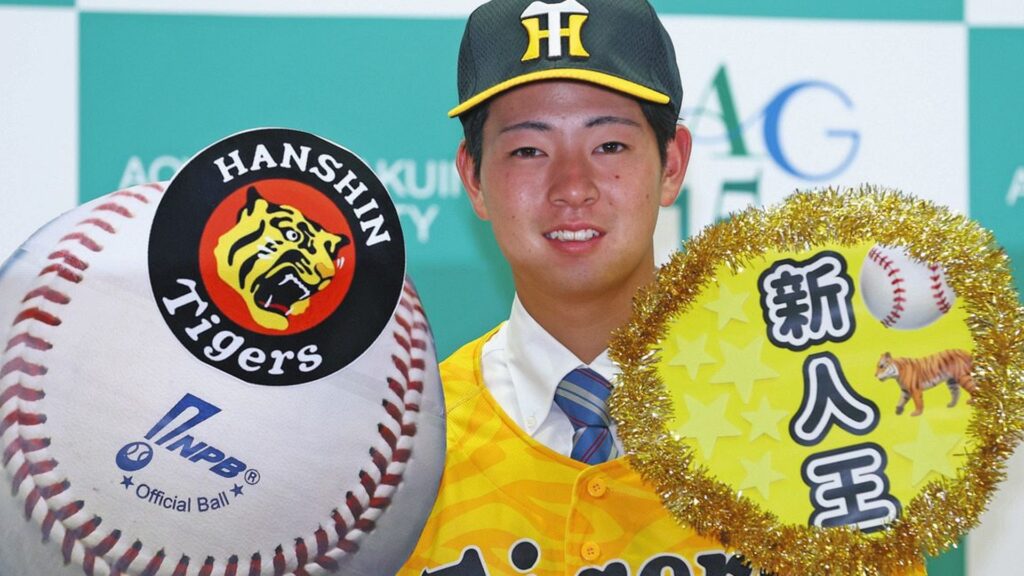
Manager Akinobu Okada said he evaluated Tsunehiro as the best pitcher of the class, but the Tigers took a shot on his teammate, Kaito Shimomura, instead. While he doesn’t have the same ceiling as Tsunehiro, Shimomura was entrusted with Game 1 of the Collegiate All-Star Series against Team USA and is noted for his tenacity to make quality starts and work deep into games. Hanshin’s rotation is already stacked, so selecting a sure-handed pitcher with a high floor was not necessary, but he’ll surely get looks on the top team next season in some capacity.
In the second round, the Tigers went with right-handed reliever Tsuyoshi Shiiba of the Tokushima Indigo Sox. Shiiba arguably has the best fastball in the entire class, topping at 99 mph, and struck out nearly 12 batters per 9 innings in the highly competitive Shikoku Island League Plus this year. He wasn’t projected to go so early, but after seeing Lotte take Hikaru Ohtani, Hanshin likely felt they had to pull the trigger before any other team snatched him up. In rounds three and four, they added high school middle infielders Shuya Yamada — coming off a championship appearance at the Summer Koshien tournament — and Aoi Momosaki. It’s surprising that they decided to go for two players that have such similar playing styles, so it’ll be interesting to see how the Tigers manage their playing time on the farm. Kein Fukushima (second developmental round) is a small, speedy outfielder to keep an eye on.
The Tigers didn’t have many glaring holes on the roster, so they probably could’ve afforded to take more risks on sluggers, but did a fine job of adding depth in some key areas.
Grade: B
Orix Buffaloes (9 Pitchers, 3 Hitters)
Top Five Picks: IF Seiya Yokoyama (Ueda West HS), RHP Kosuke Kawachi (St. Catherine HS), LHP Kaisei Toumatsu (Kyoei HS), C Shuna Hori (Hotoku Gakuen HS), RHP Taito Takashima (Oji Holdings)
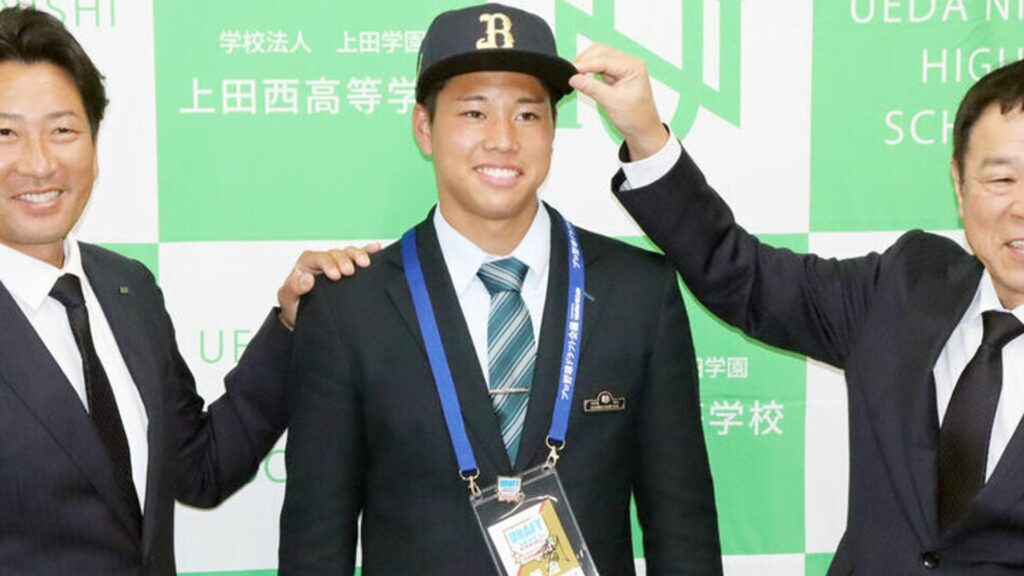
The Buffaloes have perfected the art of drafting and development in recent years, particularly in the pitching department, surpassing the Hawks as the juggernaut of the Pacific League. This draft was further evidence that they know exactly what they’re doing, taking high-upside high schoolers with each of their first four picks. Nobody knew what direction Orix would go in the first round, but they ended up with infielder Seiya Yokoyama. With soft hands and a strong arm, Yokoyama has the ability to stick at shortstop for the long haul, and his bat has a lot of promise as well. He also satisfies their need for a left-handed slugger due to Masataka Yoshida’s departure and T-Okada’s regression.
Some thought the Buffaloes would take southpaw Kaisei Toumatsu in the first round, but he fell into their laps in the third round. With dynamic strikeout stuff, Toumatsu fits the Orix brand perfectly and could easily make a quick jump in his development, as Hiroya Miyagi did just a few years ago. The addition of defense-first backstop Shuna Hori in the fourth round was also a good choice, as Tomoya Mori will likely move off the position in the future. With five of their last seven picks being independent/industrial league players, the Buffaloes also reinforced their roster in the near-term, especially when it comes to their shortage of left-handed arms.
At this point, the Buffaloes deserve the benefit of the doubt with almost any decision they make. But there are very few flaws to identify as Orix stuck to their successful formula and executed a masterful draft.
Grade: A
To Recap…
| Team | Grade | 1st Round | 2nd Round | 3rd Round | 4th Round | 5th Round |
| SoftBank | A+ | LHP Maeda | RHP Iwai | IF Hirose | RHP Murata | RHP Sawayanagi |
| Orix | A | IF Yokoyama | RHP Kawachi | LHP Toumatsu | C Hori | RHP Takashima |
| Nippon-Ham | A- | LHP Hosono | C Shinto | OF Miyazaki | IF Miyose | OF Hoshino |
| Hiroshima | B+ | RHP Tsunehiro | LHP Taka | LHP Takita | IF Nakada | RHP Akatsuka |
| DeNA | B | OF Watarai | RHP R. Matsumoto | TWP Takeda | IF Ishikami | RHP Ishida |
| Rakuten | B | LHP Koja | RHP Sakai | RHP Hinata | IF Waters | RHP Matsuda |
| Lotte | B | IF Ueda | RHP Ohtani | RHP Kimura | RHP Hayasaka | C Terachi |
| Hanshin | B | RHP Shimomura | RHP Shiiba | IF Yamada | IF Momosaki | RHP Ishiguro |
| Seibu | B- | LHP Takeuchi | RHP Ueda | LHP Sugiyama | RHP Narita | RHP Miyazawa |
| Yomiuri | C+ | RHP Y. Nishidate | LHP Morita | OF Sasaki | IF Izuguchi | LHP Mataki |
| Yakult | C+ | RHP K. Nishidate | RHP K. Matsumoto | LHP Ishihara | C Suzuki | IF Itoh |
| Chunichi | C- | RHP Kusaka | IF Tsuda | IF Tsujimoto | LHP Fukuda | RHP Habu |

